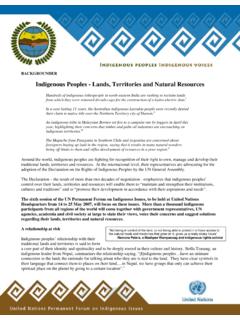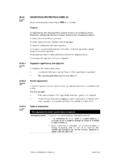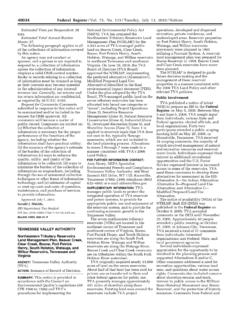Transcription of Spatially Enabling Land Administration: Drivers ...
1 Spatially Enabling land administration : Drivers , Initiatives and Future Directions for Australia Jude Wallace, Brian Marwick, Rohan Bennett, Abbas Rajabifard, Ian Williamson, Nilofer Tambuwala, Katie Potts, Muyiwa Agunbiade Centre for SDI and land administration , The University of Melbourne, Australia Abstract Spatially enabled societies demand accurate and timely information about land . Australia's land administration systems are state and territory based, administered by independent agencies. These arrangements have served the nation well. However, Australia's increasingly national economic, environmental, and social management priorities challenge their design and capacity. land management issues now require approaches based on need, not jurisdiction. Information to found sound policymaking at a national level is also essential.
2 Indeed, a national infrastructure for managing land information is an obvious tool needed by governments at all levels: national, state and territory and local. Given Australia's complex federal arrangements, an infrastructure built on existing systems that negates the need for a new national federal agency appears to be the optimal approach. In order to achieve this workable national infrastructure, eight design elements must be developed: a shared vision, a common language or ontology, a governance framework, a business case for change, selection of a data model, an accompanying technical infrastructure, an implementation/maintenance model, and an international compatibility framework. An analysis of the key national Drivers and emerging international initiatives is needed to ensure that these elements, and any others that are identified, suit national needs.
3 Extensive future research is required to achieve each of the eight design elements in the context of Drivers and global trends. Keywords: Spatially enabled society, land administration , land information, national infrastructure 1. INTRODUCTION. Spatially enabled societies demand accurate and timely information about land : land information provides the link between people and activities. In Australia, land administration has always been a state responsibility: information relating to tenure, valuation, development and land use is neither created nor managed at the national level. This situation presents challenges when issues requiring national land datasets emerge. For example, it is difficult to conduct an effective national census without an authoritative geo-coded register of addresses and land parcels. Verification of where people live is difficult and the extensive analytical possibilities provided by the spatial attribute are not available.
4 Australia now possesses these national datasets. However, many other instances where national, timely land information is essential still exist. Australia, and all nations, requires national land information frameworks if they desire to achieve Spatially enabled societies and the greater goals of sustainable development and good governance. Australia already has a number of building blocks in place for a national land information framework. Strong relationships between the states and the federal government are fostered through the Australian New Zealand land Information Council (ANZLIC). The Intergovernmental Committee on Surveying and Mapping (ICSM) coordinates the development of national technical standards relating to data production, storage, and dissemination. Management of relationships among the key agencies by the PSMA Australia Limited (PSMA Australia), an unlisted public company owned by the governments of Australia, has delivered national datasets by coordinating the aggregation of state datasets.
5 Information sets include administrative boundaries, cadastral parcels, addresses, topography, postcodes, points-of-interest and transport (Paull, 2009). These building blocks have served Australia well over the last decade; however, they are only a starting point. Large amounts of disaggregated land data and transaction processes remain at the state and local levels. Moreover, as spatial technologies become more ubiquitous, many new initiatives are emerging from the federal government, the private sector, and national coordination bodies, sometimes in non-traditional land administration sectors. Any new concept of a national infrastructure for managing land information must be built on existing achievements. While acknowledging the success of Australia's spatial industry, a clear national vision or framework for organizing land information appears to be lacking.
6 This paper aims to explore the need and nature of a national land administration infrastructure in the Australian or federated context. While the need for these systems is generally agree upon at different levels of government across different countries ( United States), the Drivers and design elements have not been researched quantitatively or qualitatively in the Australian context. The paper uses an exploratory research method to understand the nature and design of a national infrastructure for managing Australia's land information. The Drivers requiring national datasets and the activities and changes required to deliver them are studied. The land datasets and administrative processes requiring aggregation also receive attention. To deliver new services and products on a national scale, policy, legal, institutional, and technical elements of a suitable framework are also investigated.
7 2. DESIGNING THE INFRASTRUCTURE: METHOD AND APPROACH. Preliminary studies have been undertaken into the nature and design elements of a national infrastructure for managing land information within Australia. They are based around an exploratory case study, as opposed to descriptive and explanatory case studies ( Yin, 1993), of the Australian context. The case study was qualitative in nature. First, it focused on identifying national and federal Drivers through analysis of prominent problem cases emerging from reports by peak industry bodies ( Real Estate Institute of Australia) and parliamentary inquiries conducted by the Australian Federal Parliament over a period of five years (2005-2010). Second, Australia's existing land administration arrangements were reviewed to identify limitations and opportunities. Third, emerging technologies and their applicability to the Australian context were studied.
8 This lead to the creation of the design elements and determination of future research directions (Figure 1). Figure 1. Research Approach 3. IDENTIFICATION OF THE NATIONAL Drivers . The Drivers for a national land information infrastructure are complex and change frequently, as political, scientific and environmental debates raise policy issues. For convenience, the Drivers can be classified into the following categories: economic management, environmental management (built and natural), social management, harmonized governance, and technological possibilities (Figure 2). Figure 2. National Drivers for an Infrastructure to Manage Australian land Information Economic management land in Australia is a fundamental resource for economic activity. land as a physical commodity is subject to economic forces of supply and demand similar to any commodity or service (Jeffress, 1991).
9 The greater the demand for land , the higher the value of the land . The economic theory of derived demand suggests that the demand for land information and public access to the information is tied to the increasing value of land and increasing complexity of the land related commodities. The increased value of land information should lead to improvements in recording procedures to deliver more cost effective access to land information resources. In Australia, trends towards sharing land information are more obvious than ever before. Institutional barriers to SDIs are rapidly diminishing. The need to share data to solve state and federal issues is increasingly recognised. For example, a seamless national economy such as that espoused by the Council of Australian Governments Reform Council (COAG Reform Council, 2009) demands data sharing by those contributing to and governing the economy.
10 Information sharing was also recognized in the National Market for Retail Leases' report prepared by the Australian Government's Productivity Commission (Australian Government Productivity Commission, 2008). From an economic perspective, the need to present land and property information on a coherent national scale is now undeniable. A national infrastructure for land information in Australia is the next step to achieving greater economic efficiency in land administration . The transferability of rights in land underpins an active and secure land market that plays a key role in the country's economic situation. However national banks, insurers, property and superannuation funds, and developers struggle with the jurisdiction based laws and processes in a market that is increasingly national in focus. Australians are increasingly mobile and expect land markets to have similar features throughout the nation.







